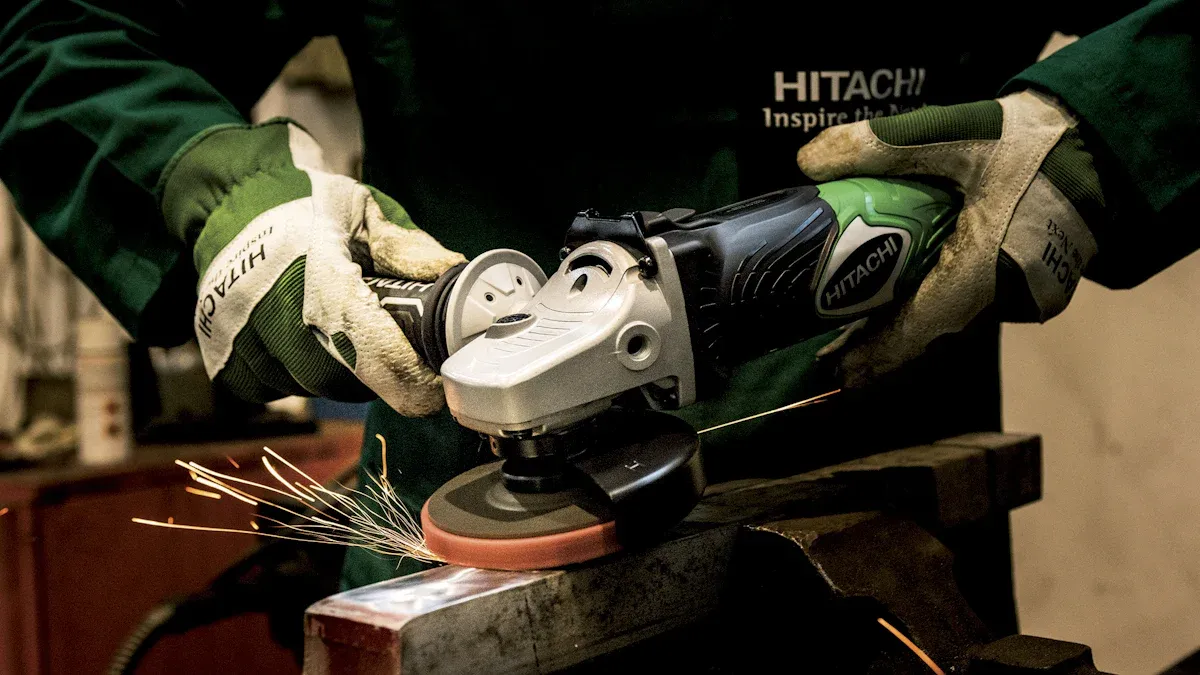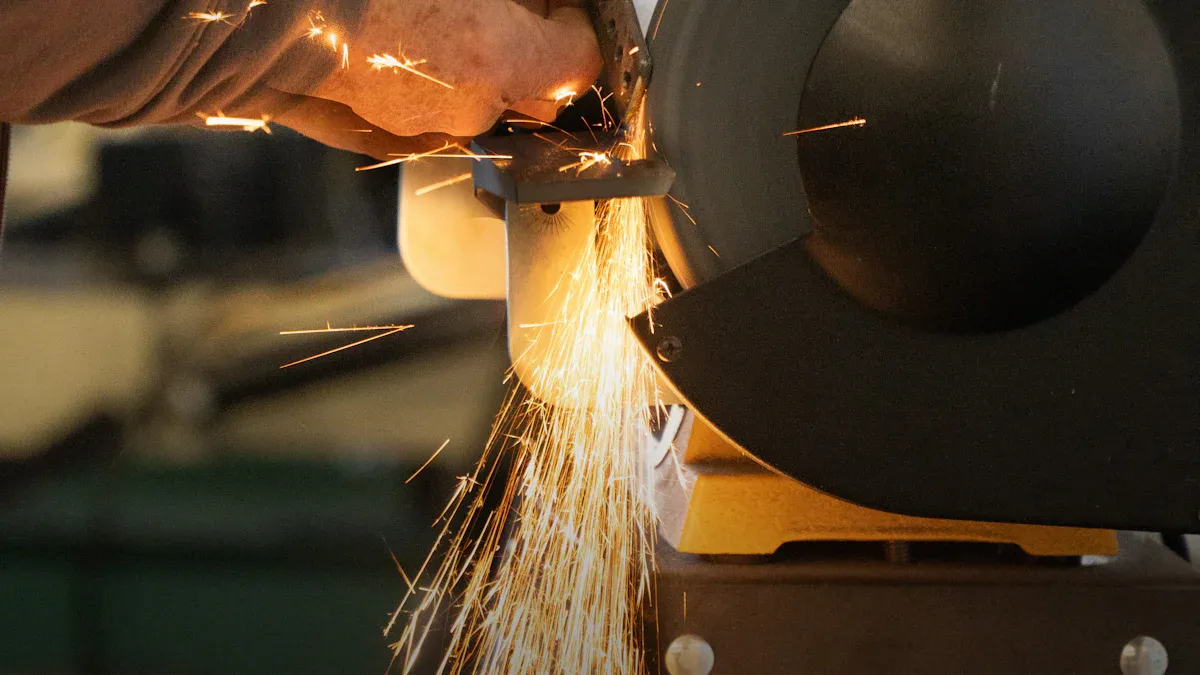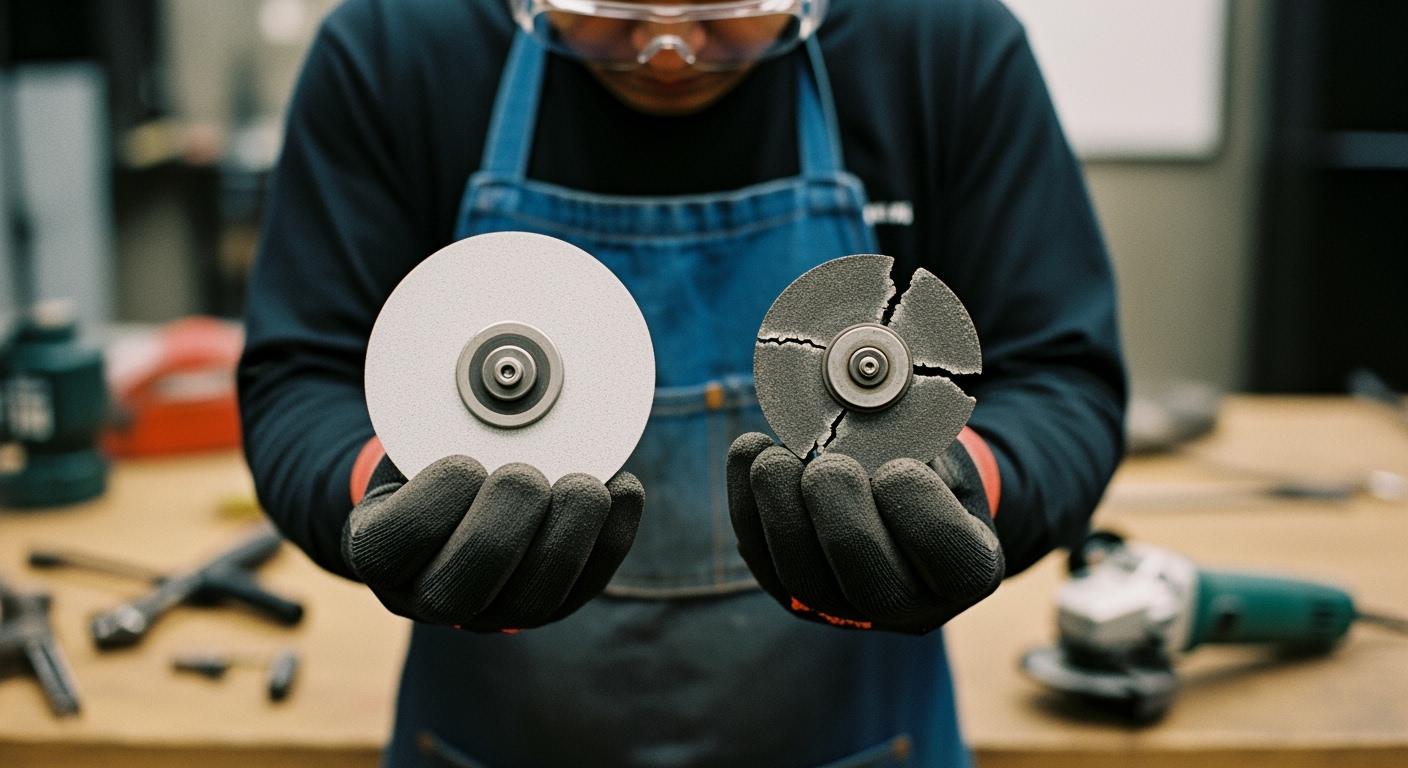You must replace grinding wheel immediately if it has cracks or chips. You should also plan for a grinding wheel replacement when its performance declines. Timely replacement is crucial for your personal safety. Before every use, you must inspect the wheel to confirm it is free from cracks or other damage.
Safety Alert: Using a compromised wheel is a major safety risk. It can lead to wheel failure and serious injury. Never take a chance with a damaged wheel.
Key Takeaways
- Always check your grinding wheel for cracks or chips before you use it. A damaged wheel is very dangerous.
- Replace your wheel if it does not cut well or if the motor sounds strained. A worn wheel makes your work harder.
- Listen for strange noises or feel for strong vibrations. These signs mean something is wrong with the wheel.
- Know when to dress your wheel to clean it. But replace it if dressing does not fix the problem or if it is too worn.
- Your safety is the most important thing. If you are not sure about a wheel, replace it.
Top Signs to Replace Grinding Wheel

Knowing the signs of a failing wheel is key to safe and effective grinding. Your senses—sight, hearing, and touch—are your best tools for inspection. Pay close attention to how the wheel looks, sounds, and feels during operation. Any change can signal a need for a grinding wheel replacement.
Visible Damage of a Grinding Wheel
You should always start with a visual check. This is the most direct way to spot trouble. Look for any visible damage of a grinding wheel before you even turn the grinder on. Even small flaws can lead to a catastrophic failure under the stress of high-speed rotation.
Common signs of visible damage include:
- Cracks: Hairline fractures can be hard to see. A bright light and a magnifying glass can help you spot them.
- Chips: Pay close attention to the edges and corners of the wheel for any missing pieces or significant chips.
- Impact Marks: Dropping or bumping a wheel can cause damage that weakens its structure. Never use a wheel that has been dropped.
Pro Tip: The Ring Test
You can detect hidden cracks with a simple “ring test.” Suspend the wheel and gently tap it with a non-metallic object, like a wooden screwdriver handle. A healthy wheel produces a clear, high-pitched ring. A dull thud means the wheel is likely cracked and you must replace it immediately.
Performance Decline and Slow Cutting
Is your grinder working harder to get the same results? This is a classic sign of performance issues of a grinding wheel. A worn or damaged wheel loses its cutting ability, forcing the motor to work overtime. This diminished grinding efficiency not only slows you down but also puts extra strain on your equipment.
You might notice:
- The grinder motor sounds strained or seems to lose power.
- You need to apply more pressure to remove material.
- The job takes significantly longer than it used to.
These symptoms of reduced cutting ability indicate that the abrasive grains are no longer sharp enough to cut effectively. Continuing to use the wheel will only generate more heat and lead to poor results. This is a clear signal that it is time to replace a grinding wheel.
Wheel Wear and Depletion
All grinding wheels wear down with use. This process is called wheel wear and depletion. As the wheel gets smaller, its performance changes. A smaller diameter reduces the wheel’s surface speed, which can make it act more aggressively and wear out even faster. Your goal is to monitor this depletion and know when to stop.
Look for these indicators of wheel wear and depletion:
- The wheel has worn down to the metal mounting plates or flanges.
- The wheel’s diameter has shrunk so much that the machine’s guard interferes with your workpiece.
- For many bench grinders, a wheel diameter of 3 to 4 inches is a common replacement point.
Ignoring wheel wear and depletion is dangerous. An overly worn wheel lacks the structural mass to operate safely and its performance will be poor. Timely replacement is essential for maintaining both safety and efficiency.
Glazing, Loading, and Overheating
Sometimes, the wheel’s surface tells you everything. Two common performance issues of a grinding wheel are glazing and loading.
- Glazing: A glazed wheel looks shiny and feels smooth. This happens when the abrasive grains become dull from prolonged use or too much pressure. The wheel stops cutting and starts rubbing, which generates intense heat and can cause surface burn on your workpiece.
- Loading: A loaded wheel is clogged with material from the workpiece, especially when grinding soft metals. This clogging prevents the abrasive grains from making contact, which reduces cutting ability and also increases heat.
Both conditions reduce the wheel’s efficiency and can damage your project. While dressing the wheel can sometimes fix these problems, severe or recurring glazing and loading mean a replacement is necessary.
Excessive Vibration or Unusual Noises
Your grinder should run smoothly. If you notice increased vibration or strange sounds, stop working immediately. These are serious warnings that something is wrong with the wheel or the machine itself.
Listen for these sounds:
- Chatter: A vibrating noise that may leave wave-like marks on your workpiece.
- Clicks or Creaks: These can indicate developing cracks or loose components.
- Rumbling or Grinding: These noises often point to worn-out motor bearings or an unbalanced wheel.
Excessive vibration can be caused by an improperly mounted wheel, an out-of-balance wheel due to uneven wear, or internal damage. Do not try to “work through” the vibration. Power down the machine and inspect it. If you cannot easily fix the source of the vibration, you must replace grinding wheel to ensure safety.
Safety Concerns Related to a Grinding Wheel

Understanding the safety concerns related to a grinding wheel is not optional; it is essential for your protection. A spinning wheel holds a surprising amount of energy. For example, a standard wheel rotating at 1200 RPM has the same kinetic energy as a brick dropped from 225 feet. If that wheel fails, fragments fly off at high speed, creating serious safety risks.
The Risk of Wheel Failure
Wheel failure is a catastrophic event. Most wheels break during startup or from severe abuse. This is why you must always stand to the side when starting a grinder. Documented accidents show the grave reality of these failures. Between 1990 and 1997, seven fatalities occurred in the US from workers being struck by pieces of a disintegrating wheel. Other common injuries include deep cuts to arms and feet. Following safety protocols is your best defense against these dangers. A timely replacement of a worn or damaged wheel is a critical part of these protocols.
Checking the Expiration Date
Many users do not realize that grinding wheels have a recommended lifespan. The bonding agents that hold the wheel together can degrade over time, especially when exposed to humidity. This weakens the wheel’s structure and increases the risk of failure.
Norton, a major manufacturer, recommends that you use resinoid, rubber, and shellac bonded wheels within two years of their manufacture date. While vitrified wheels are more durable, they do not have an infinite shelf life.
Always check for an expiration date, which is often printed on the wheel’s center ring. Adhering to the recommended lifespan is a simple step to improve your safety. If a wheel is past its date, you should replace a grinding wheel to avoid unnecessary risk.
Damage from Improper Handling
Your actions directly impact a wheel’s integrity. Dropping a wheel or storing it improperly can cause unseen internal damage. You should handle wheels carefully and store them in a dry, organized space where they cannot be bumped or struck. Before you mount any wheel, you must perform a “ring test” to check for hidden cracks. Following the manufacturer’s guidelines related to a grinding wheel for handling and storage is one of the best practices for replacement of a grinding wheel. A proper grinding wheel replacement starts with ensuring the new wheel is free from damage. This commitment to safety protects you and your equipment.
Special Considerations for High-Performance Wheels
Standard grinding wheels handle many jobs well. However, some tasks require specialized tools. Brands like Aimgrind focus on high-performance, customized abrasive tools for precision work. These advanced wheels are an investment in quality and efficiency. You must know when to replace them to protect that investment and maintain excellent results.
Inspecting Aimgrind Diamond Grinding Wheels
Aimgrind’s diamond grinding wheels are engineered for durability. You can use them to grind extremely hard materials like ceramics, composites, and hard alloys with great precision. While these wheels last a long time, they are not indestructible. They still experience wear and can suffer damage from improper use or accidents.
You should inspect these high-performance wheels just as you would any other. Look for signs of uneven wear, chipping on the diamond edge, or any other form of damage. Catching these issues early is key to ensuring consistent performance and a flawless finish on your workpiece.
Protecting Your Investment in Precision Tools
A high-performance wheel is a precision instrument. Its value comes from its ability to deliver superior results over a long period. A timely replacement is crucial for protecting your workpiece from damage and maintaining the tight tolerances required in precision jobs. Continuing to use a worn or damaged wheel compromises its cutting ability and can ruin expensive materials.
While specialized wheels have a higher initial cost, their longevity and efficiency provide significant value.
Despite higher initial costs, the long-term savings from increased tool lifespan and reduced downtime drive adoption among contractors and industrial users.
Proper care and knowing the right time for a replacement ensures you achieve peak performance. This practice maximizes the return on your investment and keeps your operations running smoothly.
Maintenance: When You Don’t Need to Replace a Grinding Wheel
Sometimes, a drop in performance does not mean you need a new wheel. Proper maintenance can often restore your wheel’s cutting ability. Regular inspections and maintenance of a grinding wheel are key to extending its life and ensuring peak efficiency. This simple maintenance can save you time and money.
Dressing a Wheel to Restore Its Surface
When your wheel becomes glazed or loaded, you can perform a maintenance task called dressing. Dressing cleans the wheel’s surface and exposes fresh, sharp abrasive grains. This process restores the wheel’s cutting efficiency. You have several tools available for this maintenance.
- Single-Point Dressers: These use one diamond point and are great for precision tasks.
- Multi-Point Dressers: These have several diamond points and work well for high-volume operations.
- Dressing Sticks: These are simple blocks of bonded abrasives used to clean the wheel.
How to Dress Your Wheel
To perform this maintenance, let the grinder reach full speed. Then, gently press the dressing tool evenly across the wheel’s face. The wheel’s rotation will help the tool clean away debris. This quick maintenance task makes a big difference.
When Dressing Is Not Enough
Dressing is a powerful maintenance technique, but it has limits. It cannot fix structural damage. You should never try to dress a wheel that is cracked, chipped, or has passed its expiration date. Dressing also cannot reverse significant wheel wear or depletion. Once the wheel wears down too far, its structural integrity is compromised.
If dressing fails to improve performance, or if the wheel shows signs of physical damage, you must replace it. This is one of the best practices for replacement of a grinding wheel. The goal of regular inspections and maintenance of a grinding wheel is to keep it working safely. When maintenance is no longer enough to correct depletion, replacement is your only safe option. Regular inspections will help you make the right call.
You must replace grinding wheel if you see cracks or feel strong vibrations. A drop in performance also signals a needed grinding wheel replacement. Your safety is the top priority. A timely replacement is always the best choice.
When you question a wheel’s condition, you should replace a grinding wheel. This simple replacement protects you from harm.
Grind with Passion, Achieve with Aim.
FAQ
What is the most important reason to replace a grinding wheel?
Your safety is the most important reason. A damaged wheel can shatter at high speeds, sending sharp pieces flying. You must replace any wheel with cracks or chips immediately to prevent serious injury. Never take a risk with a compromised wheel.
Can I repair a small chip on my grinding wheel?
No, you should never try to repair a chipped wheel. Even a small chip weakens the wheel’s structure and makes it unsafe. The only safe solution is to discard the damaged wheel and install a new one.
How often should I inspect my grinding wheel?
You should inspect your wheel before every use. A quick visual check for cracks, chips, or glazing takes only a few seconds. This simple habit is one of the best ways to ensure your safety and maintain good performance.
What does a “dull thud” mean during a ring test?
A dull thud indicates a hidden crack or internal damage. A healthy wheel will produce a clear, high-pitched ring when tapped. If you hear a thud, the wheel is unsafe. You must discard it and use a new one.
See Also
Selecting the Optimal Grinding Wheel for Your Circular Saw Blade
Picking the Perfect Grinding Wheel for Your Carbide Tooling Needs
Selecting the Ideal Bench Grinding Wheel Material for Specific Tasks
Finding the Appropriate Metal Grinding Wheel for Your Fabrication Project
Identifying the Correct Grinding Wheel for Stainless Steel Applications
Contact Us
For More Grinding Solution or Customized Abrasive Tools

